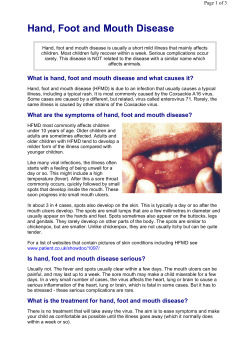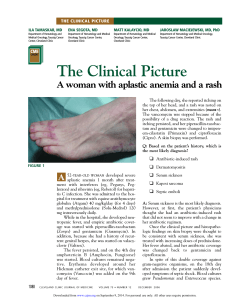
CHILDHOOD DISEASES
This is intended as a general guide. Consult a health care provider for diagnosis and for recommendations or advice. Notify the Leeds, Grenville and Lanark District Health Unit if there is a higher than usual number of cases of any disease. CHILDHOOD DISEASES Designated Reportable Diseases Illness Chickenpox (varicella virus) This disease is vaccine preventable. Fact Sheet Click here for the Reportable Disease Form or call the Health Action LIne 1-800-660-5853 How it Spreads • contact with blister fluid or saliva of an infected person • can also spread through the air; enters the body through the nose or mouth • a pregnant woman can pass it on to her baby before birth Diarrhea and Vomiting • germs are found in vomit and stool Gastroenteritis (norovirus, rotavirus) Fact Sheet (poop) of an infected person and can spread to another person’s mouth usually through unclean hands How to Recognize When it is Contagious When to Report/Exclude • begins with a fever, then an itchy • usually 1-2 days before the appearance of red rash develops and quickly turns rash and until all blisters are crusted over; into fluid filled blisters usually 5 days • blisters dry and scab over usually • incubation period *2-3 weeks within 5 days • for schools, report to the health unit via health unit’s Chickenpox and Influenza-Like Illness (ILI)reporting form • child can return to school when fever is gone and child feels well enough to participate in normal activities (regardless of the state of rash) • pregnant and immunocompromised individuals should be informed of possible exposure and advised to consult with a health care provider • vomiting, diarrhea (unformed or watery stool), fever, loss of appetite, stomach pain, fatigue, headache • while diarrhea and/or vomiting are present and up to 48 hours after symptoms stop • incubation period *24-72 hours • report outbreaks in daycare settings immediately if 2 or more children are ill within 24 hours • exclude for 48 hours after symptoms have stopped • if related to a cold, may have runny nose, cough, sneezing, or fever • complaints of painful ear, tugging on the ear, irritability (especially infants) • not usually contagious, however if fluid is draining from the ear it may contain germs • always wash hands thoroughly to prevent the spread of germs • no exclusion required if well enough to participate in regular activities • may require antibiotic treatment • a few days before the rash starts; once the rash appears, the virus is no longer contagious • incubation period *4-20 days • no exclusion required if child feels well enough to participate in activities • If you are pregnant and your child becomes ill with fifth disease or you have had an exposure to someone with fifth disease, call your health care provider Ear Infection • usually follows a cold (viral upper respiratory infection) • sometimes germs travel from the throat to the ear through a damaged Eustachian tube (connects the ear to the throat) Fifth Disease • contact with secretions from the nose • low grade fever, headache, coldlike symptoms, stomach upset, red and mouth of an infected person rash on cheeks (i.e. sneezing) • after 1-4 days a lace-like rash • can spread from a pregnant woman to appears on the body; the rash can her unborn child last up to 3 weeks Hand, Foot & Mouth Disease • contact with secretions from the nose and mouth of an infected person (i.e. sneezing) • germs are also found in stool (poop) of an infected person and can spread to another person’s mouth usually through unclean hands Impetigo • usually follows a scrape or an insect bite • rash with a cluster of red bumps or blisters around the mouth, nose, or • contact with rash; contact with bedding, other exposed parts of the skin towels, or clothing that have touched an • may ooze or be covered by a infected person’s skin honey-colored crust • from onset of rash until 24 hours after the start of antibiotic • maintain good hand washing after touching infected skin • exclude for 24 hours after the start of antibiotics or until rash is healed Influenza • sudden fever, chills, headache, • contact with secretions from the fatigue, muscle aches, cough, and nose or mouth of an infected person sore throat (i.e. sneezing, coughing) • contact with objects (i.e. surfaces, toys, • children may also have upset stomach, vomiting, diarrhea, ear doorknobs) exposed to droplets from an aches, and red eyes infected person • 24 hours before and up to 7-10 days after symptoms begin (for children) • incubation period *1-3 days • for schools, report to the health unit via health unit’s Chickenpox and Influenza-Like Illness (ILI)reporting form • exclude until fever is absent for at least 24 hours (with no over the counter medications) and the child feels well enough to participate in regular activities Measles • contact with secretions from the nose or mouth of an infected person • can also spread through the air (i.e. coughing, sneezing, talking) or contamination of surfaces (the virus can remain active in the air or on surfaces for at least 2 hours) • fever, runny nose, cough, • measles is highly contagious • report to the health unit immediately drowsiness, irritability and red eyes • usually 4 days before and up to 4 days after • exclude for at least 4 days after start of rash (usually begins 7-18 days after rash begins • contacts of case with no history of immunization exposure), small white spots on the • incubation period *7-18 days from exposure to or measles infection should be excluded for inside of the mouth and throat onset of fever 21 days • in a few days a blotchy red rash appears on the face and progresses down the body Meningitis • Bacterial: direct contact with secretions from nose or throat of an infected person (sharing dishes, toothbrushes, mouth guards) • Viral: complication from a viral illness; germs in stool (poop) of an infected person can spread to another person’s mouth through unclean hands • fever, fatigue, drowsiness, reduced consciousness, irritability, fussiness, agitation, severe headache, vomiting, stiff neck, pain when moving head or neck, joint pain, skin rash, seizures Mononucleosis • spreads person-to-person through saliva • 50% of people have no symptoms (i.e. kissing, sharing beverages) • fever, sore throat, fatigue, swollen glands, enlarged spleen • not highly contagious; can persist for a year or • no exclusion required; consult physician about more after infection avoiding contact sports until fully recovered • incubation period *4-6 weeks Mumps • contact with secretions from the nose or mouth of an infected person • contact with objects that have been exposed to droplets or saliva from an infected person • fever, swelling and tenderness of one or more salivary glands • 7 days before and up to 5 days after onset of swollen glands • incubation period *12-25 days • report to the health unit immediately • exclude for 5 days after onset of swollen glands Pink Eye Conjunctivitis • contact with eye secretions through contaminated fingers or articles (i.e. wash cloths or towels) • when pink eye is caused by a cold the droplets from a sneeze or cough can also spread it • redness in whites of eye, scratchy feeling or pain in eye • watery or yellowish discharge; eyelids often stick together • assume contagious until diagnosed • incubation period *24-48 hours • exclude until child has seen a doctor • for bacterial causes, exclude for 24 hours after the start of appropriate antibiotic Rubella • contact with secretions from the nose or mouth of an infected person • may affect fetus if infection occurs in pregnancy • mild fever, headache, fatigue, runny nose, red eyes, rash (small red spots) • 1 week before and at least 4 days after the rash begins • incubation period *14-21 days • report to the health unit immediately • exclude for 7 days after rash begins • pregnant contacts should be advised to consult with their doctor promptly • exclude for 24 hours after the start of appropriate antibiotic Otitis Media (bacterial or viral) Fact Sheet (parvovirus B19) Fact Sheet (coxsackie virus) Fact Sheet (staphylococcal bacteria or streptococcal bacteria) Fact Sheet (virus) This disease is vaccine preventable. Fact Sheet (measles virus) This disease is vaccine preventable. Fact Sheet This disease is vaccine preventable and is caused by bacteria or viruses. Fact Sheet (Epstein-Barr virus) Fact Sheet Infectious Parotitis (mumps virus) This disease is vaccine preventable. Fact Sheet (bacterial/viral) Fact Sheet German Measles (rubella virus) This disease is vaccine preventable. Fact Sheet • most contagious during the first week of • no exclusion required if well enough to • fever, headache, sore throat, loss illness participate in regular activities of appetite, lack of energy, vomiting • virus can be present in stool for up to 4 weeks and/or diarrhea, small painful after start of illness; always wash hands ulcers in the mouth, skin rash with thoroughly to prevent the spread of germs small blisters on hands, feet, and • incubation period *3-5 days buttocks • Bacterial: 7 days before symptoms begin to 24 hours after the start of appropriate antibiotics; incubation period depends on affecting bacteria • Viral: period of contagiousness depends on affecting virus • report to the health unit immediately • Bacterial: exclude for at least 24 hours after the start of appropriate antibiotics • Viral: exclusion may depend on the virus that is identified; consult with health unit Strep Throat/Scarlet Fever • contact with secretions from the • fever, very sore throat, headache, nose or mouth of an infected person swollen glands, trouble swallowing, (i.e. sneezing, coughing) nausea, sore stomach • if scarlet fever, can have sandpaper-like rash • 10-21 days or until 24 hours after starting appropriate antibiotic treatment • incubation period *1-3 days Whooping Cough • sharing close airspace (less than 1 • respiratory symptoms followed by meter) persistent repetitive cough ending • contact with secretions from the in gagging/ vomiting (may or may nose or mouth of an infected person not have characteristic “whoop”); (i.e. sneezing, coughing) fever is mild or absent • up to 21 days after symptoms begin if not • report to the health unit immediately treated • exclude until infected person has had at least 5 • Note: most contagious during the first 2 weeks days of appropriate antibiotic treatment when symptoms resemble a common cold • incubation period *5-21 days (group A streptococcus bacteria) Fact Sheet Pertussis (bordetella pertussis bacteria) This disease is vaccine preventable. Fact Sheet * Incubation period = Time between contact with disease and start of symptoms FACT SHEETS: www.healthunit.org/infectious/id_factsheets/id_factsheet.htm References: Heymann, 19th edition (2008) Ministry of Health and Long Term Care www.health.gov.on.ca Canadian Pediatric Society www.caringforkids.cps.ca MOHLTC Infectious Diseases Protocol 2013 www.health.gov.on.ca/en/pro/programs/publichealth/oph_standards/infdispro.aspx 1788rv JD July 2014
© Copyright 2025





















